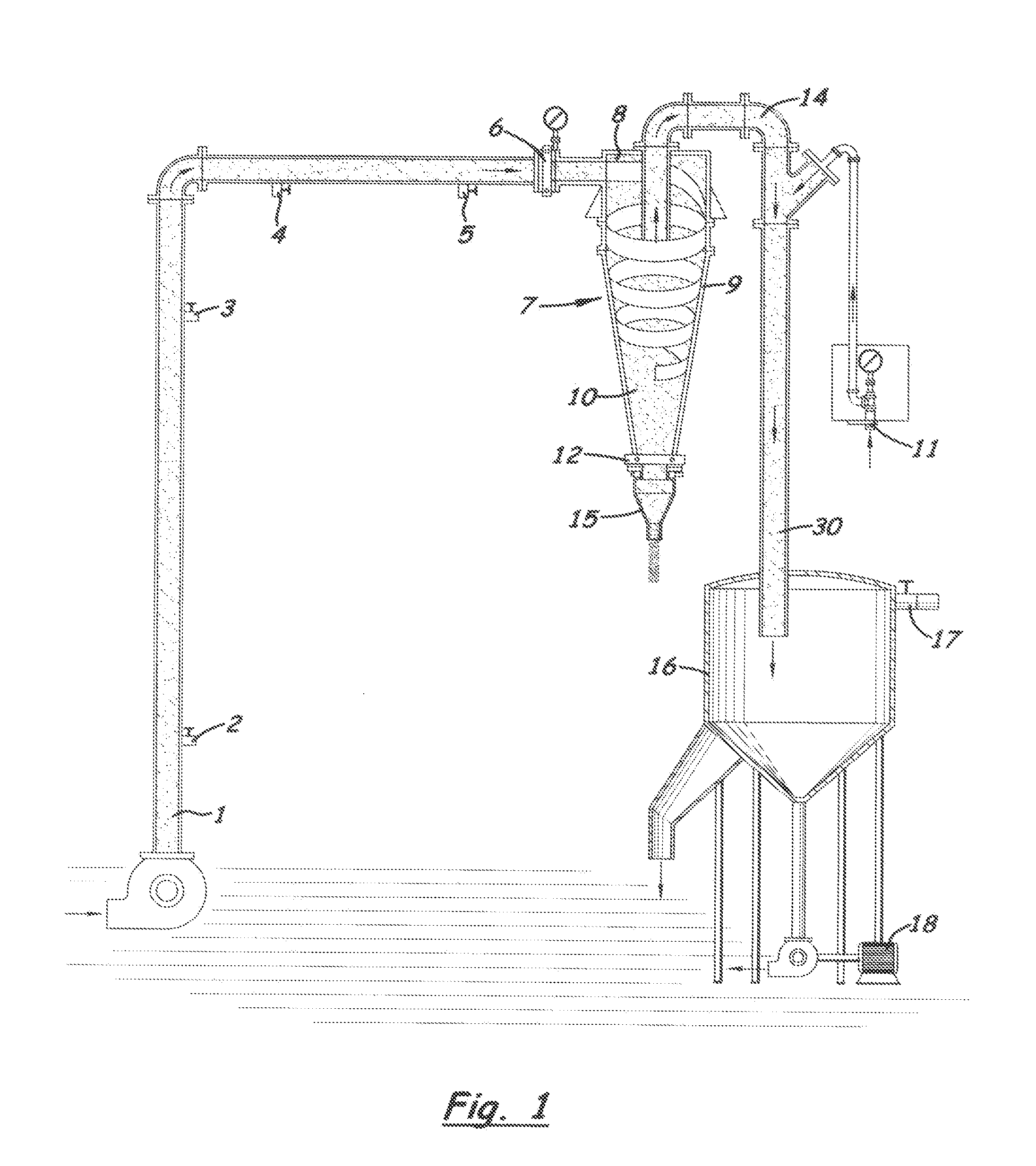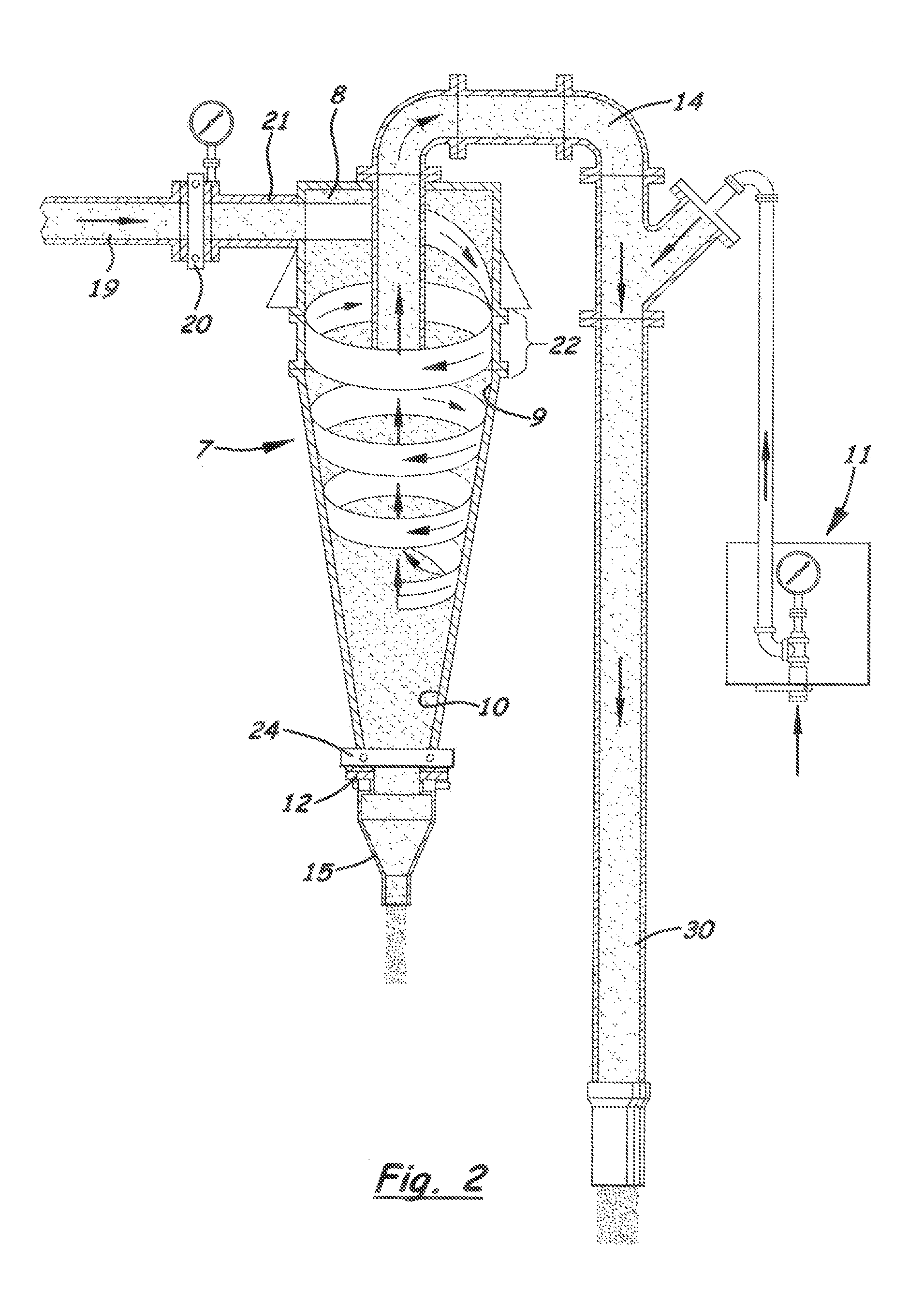Method for enhancing cyclonic vessel efficiency with polymeric additives
- Summary
- Abstract
- Description
- Claims
- Application Information
AI Technical Summary
Benefits of technology
Problems solved by technology
Method used
Image
Examples
examples 1 to 5
[0105]To provide statistical data to substantiate the unique functions of the polymeric additives on fine size particle removal from a fluid stream, a standardized test procedure was employed. This procedure being as described below.
[0106]A representative 5 gallon sample of the fine size particle stream was obtained for testing. The concentration of total suspended solids, as expressed in percent (%) was first determined. Next, 400 ml samples of various polymeric additive solutions were prepared by inverting with a hand-held mixer, such as that supplied by Braun Inc. To 400 mls of plant (on-site) clean water in a 1000 ml beaker, 1 ml of neat polymer, or polymer blend, was injected and stirred with the mixer at high speed for 20 seconds. This produced a 0.25% solution, by volume, for subsequent testing.
[0107]Testing entailed agitating the 5 gallon sample to evenly distribute the particles, then extracting a 500 ml aliquot in a 1000 ml beaker. 5–10 ppm (1–2 mls) of the cationic coagul...
example 1
[0109]
TABLE 1Granite fines slurry from quarry wash water and sand screwoverflow. Fines concentration @ 83,000TSS (8.3% solids)with 91.5% of fines passing through 200 mesh screen.Polymer TreatmentppmTSSObservations 1).Cationic Coag10 ppm83,000No Effect-Total Shear 2).Cationic Coag 5 ppmAnionic A / N10 ppm—No Effect-Total Shear 3).Cationic Coag 5 ppmAnionic N10 ppm72,300Small Effect-Highly Sheared 4).Cationic Coag 5 ppmAnionic L10 ppm—No Effect-Total Shear 5).Cationic Coag 5 ppmAnionic M10 ppm—No Effect-Total Shear 6).Cationic Coag 5 ppmAnionic H10 ppm—No Effect-Total Shear 7).Cationic Coag 5 ppmAnionic N10 ppmCationic MAP10 ppm67,400Small Flocs-Shears with mixing 8).Cationic Coag 5 ppmAnionic N10 ppmCationic L10 ppm69,500Small Flocs-Shears with mixing 9).Cationic Coag 5 ppmAnionic N10 ppmCationic M10 ppm62,200Med Flocs-Shears with mixing10).Cationic Coag 5 ppmAnionic N10 ppmCationic H10 ppm42,900Med / Large Flocs-Medium shear11).Cationic Coag 5 ppmAnionic N10 ppmCationic B-M10 ppm 8,450L...
example 2
[0111]
TABLE 2Sandstone fines slurry from quarry wash waterand sand screw overflow. Fines concentrationis 7350TSS (0.735% solids), with 100% offines passing through 200 mesh screen.92% passing through 325 mesh screen.Polymer TreatmentppmTSSObservations1).No treatment—7350No Treat2).Cationic Coag 5 ppm—No increase in size3).Anionic N 5 ppm6130small increase in size4).Anionic M 5 ppm—No increase5).Anionic H 5 ppm—No increase6).Anionic N 5 ppmCationic B-H 5 ppm1140Large flocs-undertreat7).Anionic N 5 ppmCationic B-H10 ppm 48Large / strong-clear water8).Anionic N 5 ppmCationic H 5 ppm3120Large flocs-start to break9).Anionic N 5 ppmCationic H10 ppm 883Large flocs-slight breakup
[0112]Table 2 shows a similar effect to that in Table 1, but without the need for the cationic coagulant. Again, the effectiveness of the structured cationic copolymer to resist shear is clearly demonstrated, providing greater than 99.5% removal of fine size particles from the fluid medium.
PUM
| Property | Measurement | Unit |
|---|---|---|
| Fraction | aaaaa | aaaaa |
| Fraction | aaaaa | aaaaa |
| Fraction | aaaaa | aaaaa |
Abstract
Description
Claims
Application Information
 Login to View More
Login to View More - R&D
- Intellectual Property
- Life Sciences
- Materials
- Tech Scout
- Unparalleled Data Quality
- Higher Quality Content
- 60% Fewer Hallucinations
Browse by: Latest US Patents, China's latest patents, Technical Efficacy Thesaurus, Application Domain, Technology Topic, Popular Technical Reports.
© 2025 PatSnap. All rights reserved.Legal|Privacy policy|Modern Slavery Act Transparency Statement|Sitemap|About US| Contact US: help@patsnap.com



